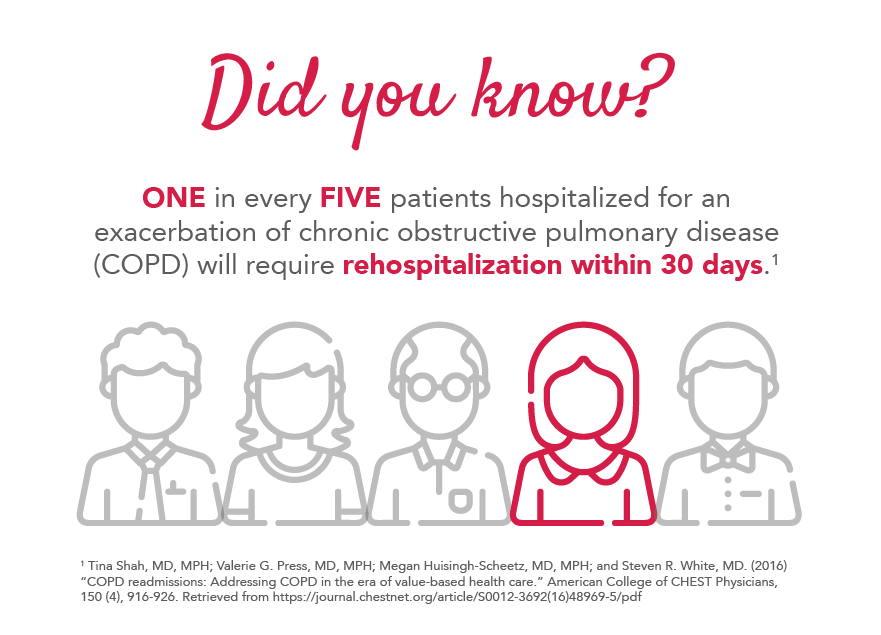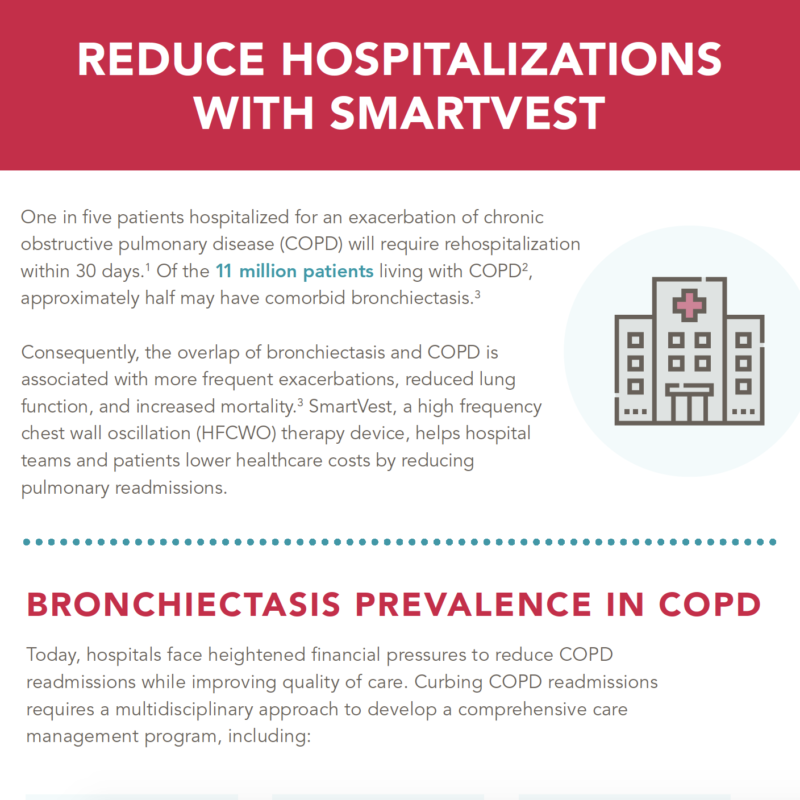
According to the American College of CHEST Physicians, one in every five patients hospitalized for an exacerbation of chronic obstructive pulmonary disease (COPD) will require rehospitalization within 30 days.[1] COPD exacerbations

develop from a severe worsening of symptoms—typically a result of a respiratory infection—and can cause:
- Narrowing of Airways
- Mucus Build Up in Airways
- Swelling & Inflammation of Airways[2]
Common signs that your patients are experiencing a COPD flare up may include:
- Frequent Coughing
- Chest Pain or Chest Tightening
- Color Changes in Sputum (e.g. green, yellow, or brown)
- Fatigue and Sleepiness[3]
If your hospital is struggling to save costs and avoid losing money on penalties from COPD readmissions, the issue may be a result of bronchiectasis prevalence in your COPD patients.
What is the Prevalence of Bronchiectasis in COPD Patients?
Bronchiectasis, an irreversible lung condition that’s characterized by recurring inflammation and infection in the lungs, shares many similarities with COPD, which may explain why clinicians are more prone to diagnose symptoms of bronchiectasis as a worsening of COPD. Experts believe that of the 11 million Americans living with COPD, approximately half of these patients may have comorbid bronchiectasis.[4] And because bronchiectasis requires airway clearance to remove mucus buildup and prevent the onset of infection, your COPD patients may not be receiving the appropriate, tailored therapy they need to manage their chronic lung condition.
The good news? The SmartVest Airway Clearance System offers a simple, effective solution to help your patients experience relief from chronic flare ups, resulting in fewer readmissions and a potential cost savings for your organization.
How SmartVest Can Help Improve Patients’ Quality of Care
From hospital to home, SmartVest offers patients an easy-to-use, high frequency chest wall oscillation (HFCWO) therapy device to help break the cycle of chronic lung infections. How the process works is once your patients receive a confirmed diagnosis of bronchiectasis, a clinician will then prescribe SmartVest to the patient and submit the request to Electromed for processing and reimbursement.
Following the SmartVest prescription, your patients can expect these next steps:
- Delivery of SmartVest to their door
- Personalized in-home or live virtual training by a Registered Respiratory Therapist
- Lifetime support for vest maintenance, troubleshooting, questions, and more
Because SmartVest offers a simple, yet effective design, your patients can perform their therapy at home, independently, creating greater patient adherence and less emergency trips to the hospital for chronic flare ups.[5]
 SmartVest Could Help Save Your Hospital Money
SmartVest Could Help Save Your Hospital Money
As the only respiratory vest on the market with proven studies demonstrating its effectiveness in treating bronchiectasis, minimizing antibiotic usage, and reducing hospitalizations, SmartVest is a smart choice for HFCWO therapy. By incorporating SmartVest into your hospital’s continuum of care program, your organization will benefit from a solution designed to reduce pulmonary readmissions and a support team committed to helping you throughout your patients’ care journey.
Your healthcare team and organization can expect the following benefits:
- Improved Patient Outcomes
- Decreased Hospitalizations[6]
- Streamlined Inpatient/Outpatient Process
In addition to reducing hospital readmission rates, SmartVest can also help streamline your HFCWO prescription process. Learn more!
Outsmart Hospital Readmission Rates with SmartVest
If your hospital is facing heightened financial pressures to reduce COPD readmissions while improving quality of care, contact Electromed today to learn how we can help support your continuum of care program and help keep your patients at home with loved ones.
Call us at 800.462.1045 to get started with SmartVest!
[1] Tina Shah, MD, MPH; Valerie G. Press, MD, MPH; Megan Huisingh-Scheetz, MD, MPH; and Steven R. White, MD. (2016) “COPD readmissions: Addressing COPD in the era of value-based health care.” American College of CHEST Physicians, 150 (4), 916-926. Retrieved from https://journal.chestnet.org/article/S0012-3692(16)48969-5/pdf
[2] American Thoracic Society. “Exacerbation of COPD.” Retrieved from https://www.thoracic.org/patients/patient-resources/resources/copd-exacerbation-ecopd.pdf
[3] American Thoracic Society. “Exacerbation of COPD.” Retrieved from https://www.thoracic.org/patients/patient-resources/resources/copd-exacerbation-ecopd.pdf
[4] The American Lung Association. “How Serious is COPD.” Retrieved from https://www.lung.org/lung-health-and-diseases/lung-disease-lookup/copd/learn-about-copd/how-serious-is-copd.html
[5] Powner, Jordan, et al. Employment of an Algorithm of Care Including Chest Physiotherapy Results in Reduced Hospitalizations and Stability of Lung Function in Bronchiectasis. BMC Pulmonary Medicine, BioMed Central. 25 Apr. 2019.
[6] Sievert CE, et al. 2016. Using High Frequency Chest Wall Oscillation in a Bronchiectasis Patient Population: An Outcomes-Based Case Review. Respiratory Therapy, 11(4), 34–38.
